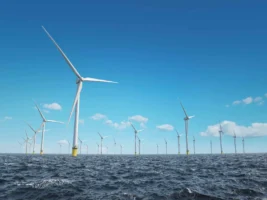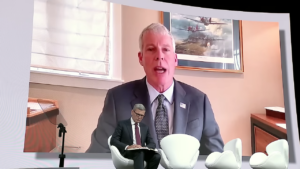Prime minister Malcolm Turnbull has extended his vision of large-scale pumped hydro and storage to Tasmania, outlining plans to expand the island’s existing hydropower system, and possibly add 2,500MW in pumped hydro, and describing the possibility that the state could become the “renewable energy battery” for Australia.
The announcement comes just weeks after Turnbull unveiled a new study to investigate the so-called “Snowy 2.0”, a plan to add 2GW – with up to 175 hours of storage – in pumped hydro capacity in the Snowy Mountains; a move that would effectively kill the prospect of new coal or gas plants.
The latest announcement, made in Launceston with the Tasmanian premier and the state-owned Hydro Tasmania on Thursday, canvasses the possibility of adding a new cable between the island and the mainland, and significantly boosting both hydro capacity and wind energy to supply “baseload” renewables to the major markets.
Turnbull said the Australian Renewable Energy Agency (ARENA) was in the process of assessing applications from Hydro Tasmania to support feasibility work into redeveloping the Tarraleah scheme and enhancing the Gordon Power Station.
It’s also considering an application to explore the utility of several new pumped hydro energy storage schemes that could deliver up to 2500MW of pumped hydro capacity: Mersey Forth-1, Mersey Forth-2, Great Lake and Lake Burbury – with capacity of around 500-700 MW each – and an alternative of nine small scale sites totalling 500MW.
“Its importance has become greater as the energy market has evolved. there is an opportunity for more wind and hydro today,” Turnbull said.
“We recognise that as the energy sources changes, we need to ensure that we have the storage … we have announced a study for the Snowy Hydro, but there is the opportunity here in Tasmania.
“It can double the capacity of hydro Tasmania, and it has the best wind assets in Australia. The roaring forties … are fantastic for wind farms. There is an opportunity for Tasmania to play a bigger part in ensuring that Australia has reliable and affordable energy, and meet emission reduction targets.
“Tasmania could become a renewable battery storage for Australia in an era of distributed, renewable power.”
The announcement came in tandem with the release of a study by Dr John Tamblyn into a second interconnector. Dr Tamblyn’s report finds another interconnector might be beneficial, but will depend on the ongoing development of the electricity system in Tasmania and the National Electricity Market.
Hydro Tasmania’s CEO Steve Davy said the company was looking to upgrade and expanding Tasmania’s hydropower network, as well as the potential for new private wind farm development and pumped storage opportunities, “to help lead Australia through the challenging (energy) transition.”
“We have nation-leading expertise in integrating renewable energy into the grid in a stable and affordable way. We’ve done that innovatively and successfully in Tasmania, and it’s the very challenge mainland Australia is starting to grapple with,” Davy said in a statement.
The studies would include an investigation into replacing one of Tasmania’s oldest operating power stations at Tarraleah in the Central Highlands, and expanding it from around 550GWh of renewable energy each year to more than 760GWh. The proposal involves constructing a 17-kilometre long underground tunnel from Lake King William and adding pumped hydro capacity.
There is also a study to add a third, smaller turbine to the Gordon power station, the largest in Tasmania, and the only station on the Gordon/Pedder scheme.
Addendum: Mike Sandiford from the Melbourne Energy Institute wrote two years ago about the opportunities for wind and hydro export from Tasmania, noting that even with the current Basslink, which was able to sustain an additional 500MW of additional northward flow, it could accommodate as much as 1400MW of new wind.
“We have glimpsed an opportunity for Tasmania in a carbon constrained world as a net energy exporter. Not without some sense of irony, Tasmania’s long investment in hydro makes it the greenest, low-emission power supplier in Australia by a very long margin.
“As a window into a carbon constrained world, the last few years have shown us just how well positioned Tasmania is by virtue of being connected via Basslink directly into one of the developed world’s most emission intensive jurisdictions – namely Victoria.
“The catch is that over the long-term Tasmania has only enough generation capacity to provide for itself. With its power supply vulnerable to the vicissitudes of the seasonal rainfall variability, the primary roles of Basslink to date have been to provide Tasmania with security of supply and, for its generators, a market arbitrage opportunity.
“But the carbon pricing years show how Basslink also provides Tasmania with the infrastructure for sustained export of electricity, should it increase generation capacity.
Hydro has particular value in managing electricity systems in a carbon constrained world. With its large storage capacity, and ability to adjust output quickly, it provides the battery potential to firm more variable generation such as wind power.
Indeed, the inherent value of wind is increased by coupling with a large dispatch-able storage system such as hydro. Consequently Tasmania potentially provides one of the best investment opportunities for wind generation in Australia.
With Basslink able to sustain around 500 megawatts of additional northward flow, Tasmania could accommodate an investment of as much as 1400 megawatts in new wind, assuming a wind resource with a capacity factor of around 35%.
“Such an investment would cost around $2.8 billion for the generation capacity plus some for the local transmission extension to connect into Basslink. It would provide around 2000 job years during the build phase, up to 300 ongoing jobs and, depending on the cost of carbon, return around $150 – $250 million each year in wholesale market returns and a similar amount in Renewable Energy Certificates.
An additional 1.4 gigawatt capacity delivering on average 500 megawatt output, firmed by the existing hydro capacity, would generate an additional 4,400 gigawatt hours of reliable power each year, representing over 10% of the current large scale RET target, currently enshrined at 41,000 gigawatt hours.
“And the clincher for Tasmania – the investment could be entirely paid for by mainland consumers. As we glimpsed during the carbon tax years, the northward flow electrons is one way of exciting the southward flow of dollars for much needed investment in Tasmanian industry.”











